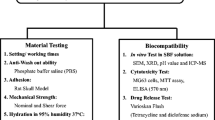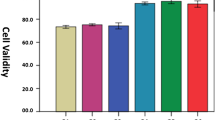Abstract
In this study, an injectable bone substitute (IBS) was produced by mixing a liquid and powder phase. The liquid phase consisted of 8 wt% methylcellulose (MC), 2.5% gelatin, and different amounts of graphene oxide (GO). The powder phase was composed of tetracalcium phosphate (TTCP), dicalcium phosphate dihydrate (DCPD), and calcium sulfate dihydrate (CSD). The results showed that 1 and 1.5 wt% GO added IBS samples showed higher stability, injectability, rheological properties, and biocompatibility than the other GO added IBS samples. GO addition significantly decreased the setting time, but it did not significantly affect the compressive strength of the samples.




Similar content being viewed by others
References
Z. Chen, X. Zhang, L. Kang, F. Xu, Z. Wang, F.Z. Cui, and Z. Guo: Recent progress in injectable bone repair materials research. Front. Mater. Sci. 9, 332(2015).
S. Larsson and T.W. Bauer Use of injectable calcium phosphate cement for fracture fixation: a review. Clin. Orthop. Relat. Res. 395, 23–32 (2002).
W.E. Brown and L.C. Chow: A new calcium phosphate setting cement. J. Dent. Res. 62, 672(1983).
M. Smiga-Matuszowicz, J. Tukaszczyk, R. Pilawka, M. Basiaga, M. Bilewicz, and D. Kusz: Novel crosslinkable polyester resin-based composites as injectable bioactive scaffolds. Int. J. Polym. Mater. Polym. Biomater. 66, 1–11 (2017).
S. Sharifi, M. Imani, H. Mirzadeh, M. Atai, F. Ziaee, and R. Bakhshi: Synthesis, characterization, and biocompatibility of novel injectable, biodegradable, and in situ crosslinkable polycarbonate-based macromers. J. Biomed. Mater. Res. A 90, 830–843 (2009).
V.V. Thai and B.T. Lee: Fabrication of calcium phosphate-calcium sulfate injectable bone substitute using hydroxy-propyl-methyl-cellulose and citric acid. J. Mater. Sci. Mater. Med. 21, 1867–1874 (2010).
M.P. Ginebra, T. Traykova, and J.A. Planell: Calcium phosphate cements as bone drug delivery systems: a review. J. Control. Release 113, 102–110 (2006).
H. Liu, H. Li, W. Cheng, Y. Yang, M. Zhu, and C. Zhou: Novel injectable calcium phosphate/chitosan composites for bone substitute materials. Acta Biomater. 2, 557–565 (2006).
M.V. Priya, A. Sivshanmugam, A.R. Boccaccini, O.M. Goudouri, W. Sun, N. Hwang, S. Deepthi, S.V. Nair, and R. Jayakumar: Injectable osteogenic and angiogenic nanocomposite hydrogels for irregular bone defects Injectable osteogenic and angiogenic nanocomposite hydrogels for irregular bone defects. Biomed. Mater. 11, 035017 (2016).
R. O’Neill, H.O. McCarthy, E.B. Montufar, M.-P. Ginebra, D.I. Wilson, A. Lennon, and N. Dunne: Critical review: injectability of calcium phosphate pastes and cements. Acta Biomater. 50, 1–19 (2017).
S. Ghanaati, M. Barbeck, U. Hilbig, C. Hoffmann, R.E. Unger, R.A. Sader, F. Peters, and C.J. Kirkpatrick: An injectable bone substitute composed of beta-tricalcium phosphate granules, methylcellulose and hyaluronic acid inhibits connective tissue influx into its implantation bed in vivo. Acta Biomater. 7, 4018–4028 (2011).
M. Krause, R. Oheim, P. Catala-Lehnen, J.M. Pestka, C. Hoffmann, W. Huebner, F. Peters, F. Barvencik, and M. Amling: Metaphyseal bone formation induced by a new injectable beta-TCP-based bone substitute: a controlled study in rabbits. J. Biomater. Appl. 28, 859–868 (2014).
H. Wang, S.C.G. Leeuwenburgh, Y. Li, and J.A. Jansen: The use of micro-and nanospheres as functional components for bone tissue regeneration. Tissue Eng. Part B Rev. 18, 24–39 (2012).
M. Dessi, M.A. Alvarez-Perez, R. De Santis, M.P. Ginebra, J.A. Planell, and L. Ambrosio: Bioactivation of calcium deficient hydroxyapatite with foamed gelatin gel. A new injectable self-setting bone analogue. J. Mater. Sci. Mater. Med. 25, 283–295 (2014).
M. Bongio, M.R. Nejadnik, F.K. Kasper, A.G. Mikos, J.A. Jansen, S.C.G. Leeuwenburgh, and J.J.J.P. van den Beucken: Development of an in vitro confinement test to predict the clinical handling of polymer-based injectable bone substitutes. Polym. Test. 32, 1379–1384 (2013).
D. Ege, A.R. Kamali, and A.R. Boccaccini: Graphene oxide/polymer-based biomaterials. Adv. Eng. Mater. 19, 1700627 (2017).
C. Baudín, T. Benet, and P. Pena: Effect of graphene on setting and mechanical behaviour of tricalcium phosphate bioactive cements. J. Mech. Behav. Biomed. Mater. 89, 33–47 (2019).
X. Zhenkun, Y. Haoran, W. Tao, W. Ruizhen, P. Zhang, L. Xiaoying, and W. Jie: Effects of adding reduced-graphene oxide/polypyrrole composites on the structure and properties of calcium phosphate cement. Chem. J. Chinese Univ. 36, 2598–2603 (2015).
C. Wu, L. Xia, P. Han, M. Xu, B. Fang, J. Wang, J. Chang, and Y. Xiao: Graphene-oxide-modified β-tricalcium phosphate bioceramics stimulate in vitro and in vivo osteogenesis. Carbon 93, 116–129 (2015).
C. Gao, P. Feng, S. Peng, and C. Shuai: Carbon nanotube, graphene and boron nitride nanotube reinforced bioactive ceramics for bone repair. Acta Biomater. 61, 1–20 (2017).
Ö.D. Oguz and D. Ege: Rheological and mechanical properties of thermor-esponsive methylcellulose/calcium phosphate-based injectable bone substitutes. Materials 11, 604 (2018).
S. Wang, S. Zhang, Y. Wang, X. Sun, and K. Sun: Reduced graphene oxide/carbon nanotubes reinforced calcium phosphate cement. Ceram. Int. 43, 13083–13088 (2017).
V. Campana, G. Milano, E. Pagano, M. Barba, C. Cicione, G. Salonna, W. Lattanzi, and G. Logroscino: Bone substitutes in orthopaedic surgery: from basic science to clinical practice. J. Mater. Sci. Mater. Med. 25, 244–2461 (2014).
S. Lian, Y. Xiao, Q. Bian, Y. Xia, C. Guo, S. Wang, and M. Lang: Injectable hydrogel as stem cell scaffolds from the thermosensitive terpolymer of NIPAAm/AAc/HEMAPCL. Int. J. Nanomedicine 7, 4893–4905 (2012).
N. Nasrollahi, A.N. Dehkordi, A. Jamshidizad, and M. Chehelgerdi: Preparation of brushite cements with improved properties by adding graphene oxide. Int. J. Nanomedicine 14, 378–3797 (2019).
Z. Liu and P. Yao: Injectable thermo-responsive hydrogel composed of xanthan gum and methylcellulose double networks with shear-thinning property. Carbohydr. Polym. 132, 490–498 (2015).
T.Y. Chiang, C.C. Ho, D.C.H. Chen, M.H. Lai, and S.J. Ding: Physicochemical properties and biocompatibility of chitosan oligosaccha-ride/gelatin/calcium phosphate hybrid cements. Mater. Chem. Phys. 120, 282–288 (2010).
J. Liu, Q. Li, and S. Xu: Reinforcing mechanism of graphene and gra-phene oxide sheets on cement-based materials. J. Mater. Civ. Eng. 31, 04019014 (2019).
B. von Lospichl, S. Hemmati-Sadeghi, P. Dey, T. Dehne, R. Haag, M. Sittinger, J. Ringe, and M. Gradzielski: Biointerfaces Injectable hydrogels for treatment of osteoarthritis–a rheological study. Colloids Surf. B 159, 477–483 (2017).
C.E. Misch, Z. Qu, and M.W. Bidez: Mechanical properties of trabecular bone in the human mandible: Implications for dental implant treatment planning and surgical placement. J. Oral Maxillofac. Surg. 57, 700–706 (1999).
S. Prasadh, S. Suresh, and R. Wong: Osteogenic potential of graphene in bone tissue engineering scaffolds. Materials 11, 1430 (2018).
S. Gurunathan, M.-H. Kang, M. Jeyaraj, and J.H. Kim: Differential cytotox-icity of different sizes of graphene oxide nanoparticles in leydig (TM3) and sertoli (TM4) cells. Nanomaterials 9, 139 (2019).
Acknowledgment
This work was supported by Boğaziçi University Research fund (No. 12240) and the Scientific and Technological Research Council of Turkey (TUBITAK) (No. 117M231).
Author information
Authors and Affiliations
Corresponding author
Supplementary material
Supplementary material
The supplementary material for this article can be found at https://doi.org/10.1557/mrc.2019.125.
Rights and permissions
About this article
Cite this article
Oğuz, Ö.D., Ege, D. Preparation of graphene oxide-reinforced calcium phosphate/calcium sulfate/methylcellulose-based injectable bone substitutes. MRS Communications 9, 1174–1180 (2019). https://doi.org/10.1557/mrc.2019.125
Received:
Accepted:
Published:
Issue Date:
DOI: https://doi.org/10.1557/mrc.2019.125




